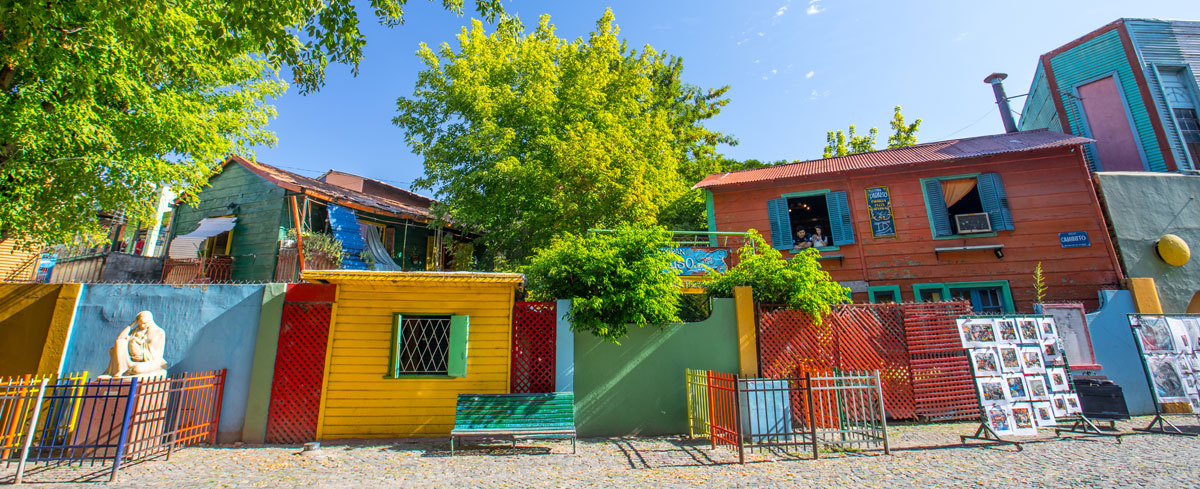When I decided to spend a day in the neighbourhood of La Boca, I was planning to take in the usual must-see attractions, the most obligatory being of course Boca Juniors’ legendary soccer stadium and the colourful open-air street museum of the Caminito.
But already on my way there on the bus, I began to get the inkling that there was more to discover in this neighbourhood. I noted old buildings and plots of land that hinted at an aristocratic past before the yellow fever epidemic of the 1870s, after which the abandoned buildings became home to the immigrants who would give La Boca the character it has to this day, and I started to feel that this neighbourhood must hold other stories not so often told.
Boca Juniors’ dream of its own city
Sticking to my plan, my first stop was La Bombonera, Boca Juniors’ famous “chocolate box” stadium. The whole complex is well worth the visit in order to absorb the history and passion behind this great team. Ever curious to know more, however, I began talking to a security guard, asking him more about the club, and a story I hadn’t heard before began to emerge: that of the then club president Alberto J. Armando’s hugely ambitious plans for the club in the 70s.
The plan was to create a sports city on the southern riverside with no less than seven artificial islands dedicated to different sports, along with entertainment options including a cafe, amusement park, amphitheatre and even areas for camping. The club was given ten years to complete the project, but a lack of funds exacerbated by rampaging hyperinflation rendered it unable to do so. The scale of ambition of the project was so incredible, that I found it impossible to imagine what the site would have been like had Armando succeeded in realising his vision.
The house of spirits
Heading back towards the bus stop, I paused to observe an impressive old building with a tower on the corner opposite. I joined the queue for the bus, but couldn’t resist asking the women in front of me if she knew what the building was. “That’s the tower of the ghosts” replied the woman, who turned out to live locally, and she proceeded to tell me the story of a young artist called Clementina who lived on the top floor, sharing the building with other artists at the start of the 20th century. One day a journalist visited and took photographs of some of Clementina’s work, which, when developed, revealed images of spirits. Days later Clementina fell from the tower. There are those that say she threw herself to her death, and others who say she was pushed by the spirits, who continue to haunt the building, making strange noises at night.
The Republic of La Boca
With this ghostly tale in my head, I took the bus and alighted near the Caminito. I crossed the road to walk close to the banks of the river, and there I saw a football pitch where three-foot high large letters proclaimed “República de La Boca”. Republic? Did La Boca have loftier aspirations beyond its status as a humble neighbourhood of Buenos Aires? Apparently so according to some residents. Some claim that, for a brief period in 1876, La Boca declared itself a republic due to a conflict between Genoan trade unions who even went as far as to write a letter to the then king of Italy. Others say that the moniker of “República” was in fact the name given to a residents’ association created at the start of the last century and which had several famous members, including some of the neighbourhood’s artists. The second version of the story sounds more credible to me, although the first is certainly very romantic.
The colours of the tenements
Engrossed in the story, without realising it, I’d finally arrived at the Caminito, which is funny because you can hardly miss it: as well as the colourful old sheet metal tenements and the effigies of local characters, there’s a buzz of frenetic activity around this picturesque street, with artists selling their work and tango dancers performing outside the restaurants. I wanted to buy some souvenirs and as I was chatting with the stallholders I heard some of the theories about the colours of the buildings around me.
One person told me that the tradition of painting the buildings this mix of bright colours came from the custom of their owners to ask for leftover paint from the different ships that passed through the port as a form of payment. Another stallholder insisted that this was a myth and that it was the local artist Benito Quinquela Martín who decided in 1959 to begin painting the houses different colours to brighten up the street, and that other people began to copy the idea.
With this intriguing blend of myth and history, my simple visit to La Boca had become all the more interesting thanks to the willingness of locals to talk and share their stories. There are undoubtedly many more things to discover, so pay a visit yourself and see what tales you are told.
See the most popular attractions in La Boca.

